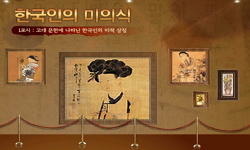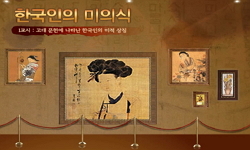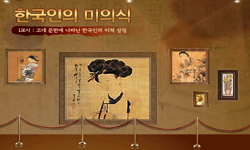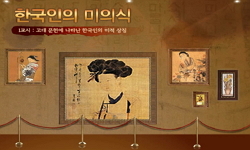It is prevalent opinion that Kim Whan?ki from the 1930s to the early 1940s was an abstract artist. As well known, Kim had strong ties with the avant-garde communities of Japan when he was a student there as well as when back to Korea while producing a...
http://chineseinput.net/에서 pinyin(병음)방식으로 중국어를 변환할 수 있습니다.
변환된 중국어를 복사하여 사용하시면 됩니다.
- 中文 을 입력하시려면 zhongwen을 입력하시고 space를누르시면됩니다.
- 北京 을 입력하시려면 beijing을 입력하시고 space를 누르시면 됩니다.
https://www.riss.kr/link?id=A102028456
- 저자
- 발행기관
- 학술지명
- 권호사항
-
발행연도
2015
-
작성언어
Korean
-
주제어
김환기(金煥基) ; 추상미술 ; 전위미술 ; 모더니즘 ; 체험 ; 감각 ; 이미지즘 ; Kim Whan-ki(金煥基) ; Avant-garde ; Modernism ; Experiences and Sensations ; Imagism
-
등재정보
KCI등재
-
자료형태
학술저널
-
수록면
161-183(23쪽)
-
KCI 피인용횟수
1
- 제공처
-
0
상세조회 -
0
다운로드
부가정보
다국어 초록 (Multilingual Abstract)
It is prevalent opinion that Kim Whan?ki from the 1930s to the early 1940s was an abstract artist. As well known, Kim had strong ties with the avant-garde communities of Japan when he was a student there as well as when back to Korea while producing abstract works. Kim later formed a neorealism community with Yoo Youngkuk and Lee KyuSang, where he seeked the ‘Neo-Reality’. He also reflected his interest in korean tradition and antiques in his work while having made an exchange with artists, poets, and writers who had worked through ‘Munjang’ that is literature magazine.
That much of the academic literature on Kim’s paintings from this period have been focused on abstract and avant-garde art and orientalism may be a natural consequence of his historical trajectory as the above.
As the advanced researches tell, Kim Whan?ki’s interest is not the departure from an object but the way ‘abstractifying’ an object, while pursuing the abstract art. This study also begins from the premise that the key element necessary for interpreting Kim’s abstract art is the way rather than the concept. I would like to go even a step further to argue that the form and content of the abstract in Kim’s work reflect the artist’s personal experiences and emotional sensations. And I’ll argue that such personal experiences-which exist on the outskirts of Kim’s abstract art-are imbued with a kind of romanticism.
To illuminate these points, I analyze the abstract features of Kim’s work that appear as geometrical designs in conjunction with the social atmosphere of the era, and also interpret the artist’s personal experiences reflected in the work through references to articles, photographs, and related written works published in the literary magazines of the day.
I attempt to show that Kim Whan-ki’s painting which abstractly portrayed the city and machines-symbols of the most cutting-edge elements of civilization- are not simply a matter of style but concrete expressions of the artist’s existential interpretations of nature, life, and modern civilization. It may seem unusual for an artist who interprets the world through the lens of existentialism to pursue such an abstract style. However, at that time, this is not unusual. This is because the avant-garde discourse in those days was developed in each artist’s personal understanding.
The experiences of the 1930s that appear in Kim’s work were personal and everyday experiences of modern civilization, and this is why his artwork includes hints at the modernist emotional connection with urban life. Kim’s nostalgia for the modern lifestyle he experienced during his student years in Tokyo occasionally appears as a landscape that is in turn representational or contemplative. These approach is similar to imagism in literature. Kim Gi-rim, a leading Korean modernist poet, defines poetry as the expression of not the mental but the “real” world in writing. Similarly, Kim Whan?ki’s work is an expression of reality as created through the artist’s memories and experiences.
목차 (Table of Contents)
- I. 시작하며
- II. 일상을 반영한 추상
- Ⅲ. 일상이 내포된 풍경
- IV. 마치며
- 참고문헌
- I. 시작하며
- II. 일상을 반영한 추상
- Ⅲ. 일상이 내포된 풍경
- IV. 마치며
- 참고문헌
- Abstract
참고문헌 (Reference)
1 고유섭, "현대미의 특성" 통문관 1993
2 김병기, "해방이전 일본에 유학한 미술인들" 삼성미술관 2004
3 문덕수, "한국모더니즘시 연구" 시문학사 1992
4 최열, "한국근대미술의 역사" 열화당 1998
5 조오장, "추상예술의 현재"
6 이인범, "추상, 그 미학적 담론의 초기 현상-1930년대 한국의 경우" 한국미술이론학회 0 (0): 135-154, 2005
7 김환기, "조광 5-8" 조선일보사 1939
8 김환기, "정열의 화가-박영선개전(個展) 평"
9 서영채, "절대 공간으로서의 풍경- 두 번째 풍경과 존재론적 순간" 한국현대문학회 (41) : 569-604, 2013
10 조오장, "전위회화의 본질-문제로써 추구키 전에" 1938
1 고유섭, "현대미의 특성" 통문관 1993
2 김병기, "해방이전 일본에 유학한 미술인들" 삼성미술관 2004
3 문덕수, "한국모더니즘시 연구" 시문학사 1992
4 최열, "한국근대미술의 역사" 열화당 1998
5 조오장, "추상예술의 현재"
6 이인범, "추상, 그 미학적 담론의 초기 현상-1930년대 한국의 경우" 한국미술이론학회 0 (0): 135-154, 2005
7 김환기, "조광 5-8" 조선일보사 1939
8 김환기, "정열의 화가-박영선개전(個展) 평"
9 서영채, "절대 공간으로서의 풍경- 두 번째 풍경과 존재론적 순간" 한국현대문학회 (41) : 569-604, 2013
10 조오장, "전위회화의 본질-문제로써 추구키 전에" 1938
11 서유리, "전위의식과 한국의 미술운동- 1920~30년대를 중심으로" 한국근현대미술사학회(구 한국근대미술사학회) (18) : 24-38, 2007
12 김환기, "요코하마의 旅愁" 조선일보출판부 19 : 1939
13 조오장, "에튜드-단상:전위운동의 제창-조선화단을 중심으로 한"
14 "신안에 ‘김환기 미술관’ 건립된다"
15 박장민, "신사실파의 추상에 나타난 서사적 특성 연구 - 순수문학과의 관련성을 중심으로" 한국근현대미술사학회(구 한국근대미술사학회) (25) : 44-78, 2013
16 조오장, "신 정신의 미래"
17 김기림, "시의 모더니티" 심설당 1988
18 유종호, "시란 무엇인가" 민음사 1995
19 오영식, "수화 김환기 글모음" 근대서지학회 (6) : 2012
20 "서양화가 김환기 작품 고향에 왔다"
21 김환기, "빠·시라무랜의 마담" 조선일보출판부 19 : 1939
22 "김환기 미술관 고향 안좌도에"
23 "김암기 전화인터뷰. 2013. 4. 29"
24 김영나, "근대한국미술논총" 학고재 1992
25 이종대, "근대적 자아의 세계 인식-'구인회' 시인들의 모더니즘" 상허학회 3 : 1996
26 Muto, Kaori, "근대 여성 이미지에 관한 비교 고찰 : 『모던 일본』 및 『모던 일본 조선판』을 주제로" 이화여자대학교 국제대학원 2014
27 김환기, "군담" 조선일보사 2 (2): 1940
28 김환기, "구하던 일 년" 조선일보사 2 (2): 1940
29 김환기, "抽象主義小論"
30 김주영, "在朝鮮 일본인 화가와 식민지 화단의 관계 고찰" 한국미술사학회 (233-234) : 2002
31 김환기, "三回國展의 明朗性"
동일학술지(권/호) 다른 논문
-
- 한국근현대미술사학회
- 서정민(Seo Jeong-min)
- 2015
- KCI등재
-
- 한국근현대미술사학회
- 조은정(Cho Eun-jung)
- 2015
- KCI등재
-
- 한국근현대미술사학회
- 정현아(Jeong Hyeon-a)
- 2015
- KCI등재
-
- 한국근현대미술사학회
- 이정진(Lee Jung-jin)
- 2015
- KCI등재
분석정보
인용정보 인용지수 설명보기
학술지 이력
| 연월일 | 이력구분 | 이력상세 | 등재구분 |
|---|---|---|---|
| 2027 | 평가예정 | 재인증평가 신청대상 (재인증) | |
| 2021-01-01 | 평가 | 등재학술지 유지 (재인증) |  |
| 2018-01-01 | 평가 | 등재학술지 유지 (등재유지) |  |
| 2015-01-01 | 평가 | 등재학술지 유지 (등재유지) |  |
| 2011-01-01 | 평가 | 등재학술지 유지 (등재유지) |  |
| 2009-01-01 | 평가 | 등재학술지 유지 (등재유지) |  |
| 2008-01-24 | 학회명변경 | 한글명 : 한국근대미술사학회 -> 한국근현대미술사학회(구 한국근대미술사학회)영문명 : Institute Of Korean Modern Art Studies -> Association of Korean Modern & Contemporary Art History |  |
| 2008-01-23 | 학술지명변경 | 한글명 : 한국근대미술사학 -> 한국근현대미술사학(구 한국근대미술사학)외국어명 : The Journal of Korean Art History -> Journal of Korean Modern & Contemporary Art History |  |
| 2006-01-01 | 평가 | 등재학술지 선정 (등재후보2차) |  |
| 2005-05-25 | 학술지명변경 | 외국어명 : 미등록 -> The Journal of Korean Art History |  |
| 2005-05-24 | 학술지명변경 | 한글명 : 한국근대미술사학 제11집 -> 한국근대미술사학 |  |
| 2005-01-01 | 평가 | 등재후보 1차 PASS (등재후보1차) |  |
| 2003-01-01 | 평가 | 등재후보학술지 선정 (신규평가) |  |
학술지 인용정보
| 기준연도 | WOS-KCI 통합IF(2년) | KCIF(2년) | KCIF(3년) |
|---|---|---|---|
| 2016 | 0.29 | 0.29 | 0.39 |
| KCIF(4년) | KCIF(5년) | 중심성지수(3년) | 즉시성지수 |
| 0.37 | 0.37 | 1.029 | 0.06 |




 DBpia
DBpia






